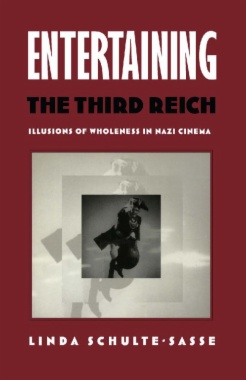In this persuasive reversal of previous scholarship, Linda Schulte-Sasse takes an unorthodox look at Nazi cinema, examining Nazi films as movies that contain propaganda rather than as propaganda vehicles that happen to be movies. Like other Nazi artistic productions, Nazi film has long been regarded as kitsch rather than art, and therefore unworthy of critical textual analysis. By reading these films as consumer entertainment, Schulte-Sasse reveals the similarities between Nazi commercial film and classical Hollywood cinema and, with this shift in emphasis, demonstrates how Hollywood-style movie formulas frequently compromised Nazi messages.
Drawing on theoretical work, particularly that of Lacan and Zizek, Schulte-Sasse shows how films such as Jew Süsss and The Great King construct fantasies of social harmony, often through distorted versions of familiar stories from eighteenth-century German literature, history, and philosophy. Schulte-Sasse observes, for example, that Nazi films, with their valorization of bourgeois culture and use of familiar narrative models, display a curious affinity with the world of Enlightenment culture that the politics of National Socialism would seem to contradict.
Schulte-Sasse argues that film served National Socialism less because of its ideological homogeneity than because of the appeal and familiarity of its underlying literary paradigms and because the medium itself guarantees a pleasurable illusion of wholeness. Entertaining the Third Reich will be of interest to a wide range of scholars, including those engaged in the study of cinema, popular culture, Nazism and Nazi art, the workings of fascist culture, and the history of modern ideology.
- Contents
- List of Illustrations
- Preface
- Introduction
- Chapter 1. Mass Spectacle, History, Cinema: Embodiments of Social Fantasy
- Part I. Two Sides of a Coin: The "Jew" and the King as Social Fantasies
- Chapter 2. Courtier, Vampire, or Vermin? Jew Suss's Contradictory Effort to Render the "Jew" Other
- Chapter 3. Frederick, the Movie; or, The Return of the King's Body: Fridericus and The Great King
- Chapter 4. Building the Body Armor: Hans Steinhoff's The Old and the Young King
- Part II. Aestheticized Genius
- Chapter 5. Duel over the Son: Herbert Maisch's Friedrick Schiller - Triumph of a Genius
- Chapter 6. Anomaly or "Facist Delusion of Female Autonomy"? Pabst's Neuberin Film Komodianten
- Chapter 7. Tribulations of a Genius: Traugott Muller's Friedemann Bach
- Part III. Beyond the Eighteenth Century
- Chapter 8. Vicious Circulation: Money and Foreignness in Nazi Film
- Movies about Money: Hans Zerlett's Robert and Bertram and Karl Hartl's Gold
- Foreign Contamination: Hitler Youth Quex, Hans Westmar, S.A. Man Brand, For Human Rights, and Pour le Merite
- Chapter 9. Nazism and Machines
- Industry: Veit Harlan's The Ruler and Gerhard Lamprecht's Diesel
- Radio and the Homefront: Eduard von Borsody's Request Concert and Rolf Hansen's The Great Love
- Chapter 10. Of Lies and Life: Munchhausen's Narrative Arabesque
- Select Bibliography
- Filmography
- Index

